Although the norm today, the crossover SUV is a relatively new invention within the car industry. In around 30 years, the segment has emerged as one of the most dominant in the industry.
The Honda CR-V is one of the original crossover SUVs. Since its launch in 1995, the CR-V has shaped the genre and become both Honda’s best-selling vehicle, and one of the best-selling crossover SUVs ever.
Despite being a global sales hit, CR-V sales in New Zealand have underperformed compared to its competitors in recent years. It’s a strange phenomenon, because the CR-V has always been a solid contender in the category. Could the 6th generation CR-V, and in particular this new hybrid CR-V RS, change Honda’s fortunes in New Zealand?

What We Like and Dislike About The 2024 Honda CR-V RS
| What we like | What we don’t like |
| Exterior design Build quality Interior space Handling improvements Driving experience Hybrid efficiency | No more magic seats Intrusive lane keep assistance Poor reversing camera resolution Somewhat on the expensive side |

What’s In the 2024 Honda CR-V RS Range?
There are four variants of the Honda CR-V for Kiwi buyers to choose from.
| Model | Powertrain | Price |
| Honda CR-V Sport AWD | Petrol | $53,000 |
| Honda CR-V Sport AWD Premium | Petrol | $55,000 |
| Honda CR-V Sport 7 | Petrol | $57,000 |
| Honda CR-V RS | Hybrid | $67,000 |
The CR-V Sport AWD is the first in the range, powered by a 1.5L turbocharged 4-cylinder V-TEC engine outputting 140kW of power and 240Nm of torque. The engine drives all four wheels via a CVT automatic transmission, with a claimed fuel economy of 8.1L/100kms.
Next in line is the CR-V Sport AWD Premium. The “Premium” component is mainly an exterior aesthetics package, with different colour rims, trims and exterior facias. It shares the same drivetrain and has the same outputs and fuel economy as the CR-V Sport AWD.
The CR-V Sport 7 is the only 7-seater in the CR-V range. Compared with the CR-V Sport AWD, the spec list is nearly the same except the CR-V Sport 7 adds a sunroof, rear climate control and a couple of extra cup holders. The drivetrain is carried over from CR-V Sport AWD, but the CR-V Sport 7 is only two-wheel drive.
The CR-V RS sits at the top of the range. It’s the only hybrid variant, powered by a 2.0L hybrid 4-cylinder outputting 135kW of power and 335Nm of torque, driving all four wheels via an “e-CVT” automatic transmission. The combination delivers a claimed fuel economy figure of 6.4L/100kms. It’s also decked to the nines with equipment, as you’d expect for the extra $10,000 over the next model.

2024 Honda CR-V RS Standard Equipment Highlights
As standard, the Honda CRV Sport AWD offers:
- 18-inch Alloys
- 8-way Power Adjustable Driver’s Seat with Memory
- 4-way Power Passenger Seat
- 7” drivers display
- 8-speaker audio system
- 9” infotainment with Bluetooth, SatNav, Apple CarPlay and Android Auto
- Auto Dimming Rear View Mirror
- Auto Rain-Sensing Wipers
- Automatic LED Headlights
- Conversation Mirror
- Dual Zone Climate Control
- Heated Leather Seats
- Honda Connect App
- Power Tailgate with Walk Away locking
- Privacy Glass
- Reversing Camera
- Roof Rails
- Wireless Charger
The Honda CRV Sport AWD Premium adds:
- 18-inch alloys in black
- Lower Front & Rear Bumper in Body Colour
- Side mirror housing in Piano Black
- Side Sill & Wheel Arches in Body Colour
- Spoiler in Body Colour and Piano Black
The Honda CR-V Sport 7 adds:
- 7-seats
- Panoramic Sunroof
- Tri-zone climate control
The Honda CR-V RS adds:
- 19-inch Black Alloys
- 12-speaker Bose Audio System with Subwoofer
- 10.2’’ Digital Drivers Display
- Adaptive headlights
- Alloy Sports Pedals
- Ambient Interior Lighting
- Auto Tilting Mirrors – Reverse
- Black Headliner
- High-Grade Sound Deadening & Insulation
- LED Active Cornering Lights
- LED Rear Fog Lamp
- Panoramic Sunroof
- Red-Stitched Leather Seats
- Smart KeyCard
All CRV models come with an array of safety features, including “Honda Sensing” safety support software. These features include:
- 11 Airbags
- Adaptive Cruise Control (ACC)
- Collision Mitigation Braking System (CMBS)
- Forward Collision Warning (FCW)
- High-Beam Support System (HBSS)
- Lane Departure Warning (LDW)
- Lane Keep Assist System (LKAS)
- Low-Speed Braking Control (LSBC)
- Low-Speed Follow (LSF)
- Road Departure Mitigation System (RDMS)
- Traffic Jam Assist (TJA)
- Traffic Sign Recognition System (TSR)
Honda Connect – an app which integrates with all CR-V models, contains the following features:
- Auto collision detection
- Car log & behaviour
- ‘Find my car’ function
- Geofencing
- Remote A/C, light and Car Status.
- Remote diagnostics
- Remote engine start
- Remote lock/unlock
- Security alarm
- Speed alert
There are six colour options available for your CR-V, including:
- Canyon River Blue Metallic
- Crystal Black Pearl
- Ignite Red Metallic
- Lunar Silver Metallic
- Meteoroid Gray Metallic
- Platinum White Pearl
For more information on the Honda CR-V, check out the Honda New Zealand website.


How Does The 2024 Honda CR-V RS Compare To Its Competition?
The world’s your oyster for mid-size crossovers, and there are plenty of hybrid options available (including a few PHEV options). Here are some of your options.
| Make/Model | Engine | Power/Torque (kW/Nm) | Seats | Fuel (L/100km) | Towing capacity | Boot space (litres) | Price |
| Mitsubishi Outlander PHEV VRX | 2.5-litre 4-cylinder plug-in | 183/450 | 5 | 1.6 | 750/1,600 | 640 | $75,990 |
| Hyundai Tucson Elite Hybrid | 1.6-litre 4-cylinder turbo hybrid | 169/350 | 5 | 5.6 | 750/1,650 | 503 | $72,990 |
| Ford Escape ST-Line X PHEV | 2.5-litre 4-cylinder | 167/NA | 5 | 1.5 | NA/1,200 | 517 | $68,990 |
| Volkswagen Tiguan Style AWD | 2-litre 4-cylinder turbo | 140/320 | 5 | 8.4 | 750/2,100 | 615 | $67,900 |
| Honda CR-V RS | 2-litre 4-cylinder | 135/335 | 5 | 6.4 | 600/750 | 581 | $67,000 |
| Mazda CX-5 Takami | 2.5-litre 4-cylinder turbo | 170/420 | 5 | 9.1 | 750/2,000 | 401 | $67,890 |
| Skoda Kodiaq Style | 2-litre 4-cylinder turbo | 140/320 | 5 | 8.0 | 750/2,100 | 765 | $64,990 |
| Nissan X-Trail e-Power Ti-L | 1.5-litre 3-cylinder turbo | 150/330 | 5 | 6.1 | 750/1,650 | 585 | $64,990 |
| Peugeot 3008 GT | 1.6-litre 4-cylinder turbo | 134/250 | 5 | 6.2 | 750/2,000 | 591 | $60,990 |
| Toyota RAV-4 Limited Hybrid | 2.5-litre 4-cylinder | 131/221 | 5 | 5.3 | 750/1,500 | 542 | $59,790 |
| Subaru Forester e-Boxer Premium AWD | 2.0-litre 4-cylinder boxer | 110/196 | 5 | 6.7 | 750/1,200 | 509 | $57,490 |
| Kia Sportage Earth Hybrid | 1.6-litre 4-cylinder turbo | 132/265 | 5 | 5.4 | 750/1,650 | 543 | $55,390 |

First Impressions Of The 2024 Honda CR-V RS
Honda can sometimes pull a complete 180-degree shift when it comes to exterior vehicle styling, as we’ve learnt from the new-generation Civic. So it ought not be a surprise when Honda takes the same approach with its new 6th generation CR-V.
However, many were rather surprised when I told them that the rather large premium-looking barge before them was the new Honda CR-V. That’s because it’s a huge departure from the previous generation, which shouldn’t actually surprise, being that it is a ground-up redesign.

The new CR-V has sharper lines, boxier elements, and premium details compared to the busy angles and bulbous features of its predecessor. It’s also longer and wider than before, growing by 80mm on the body, 10mm in width and 40mm on the wheelbase.
From the front, the CR-V’s now squared off-nose features a large black honeycomb grille, bordering a large Honda badge. Its angular LED headlights connect with a consistent line, sculpting the flanks and connecting to the rear. At the back, its wider rear arches and the cascading LED tail lights have more than a slight resemblance to a Volvo XC-90.
Altogether, the new CR-V appears rugged, yet up-market. It has more presence than its predecessors and amongst its crossover peers, the CR-V looks like the expensive one.
Solid work, Honda.

What’s The Interior Like In The 2024 Honda CR-V RS?
There’s probably a handful of readers who can vividly remember the first-gen Honda CR-V. Not only because it was a sales boon, but because the interior was a first glimmer into the practical intelligence of the Japanese automaker.
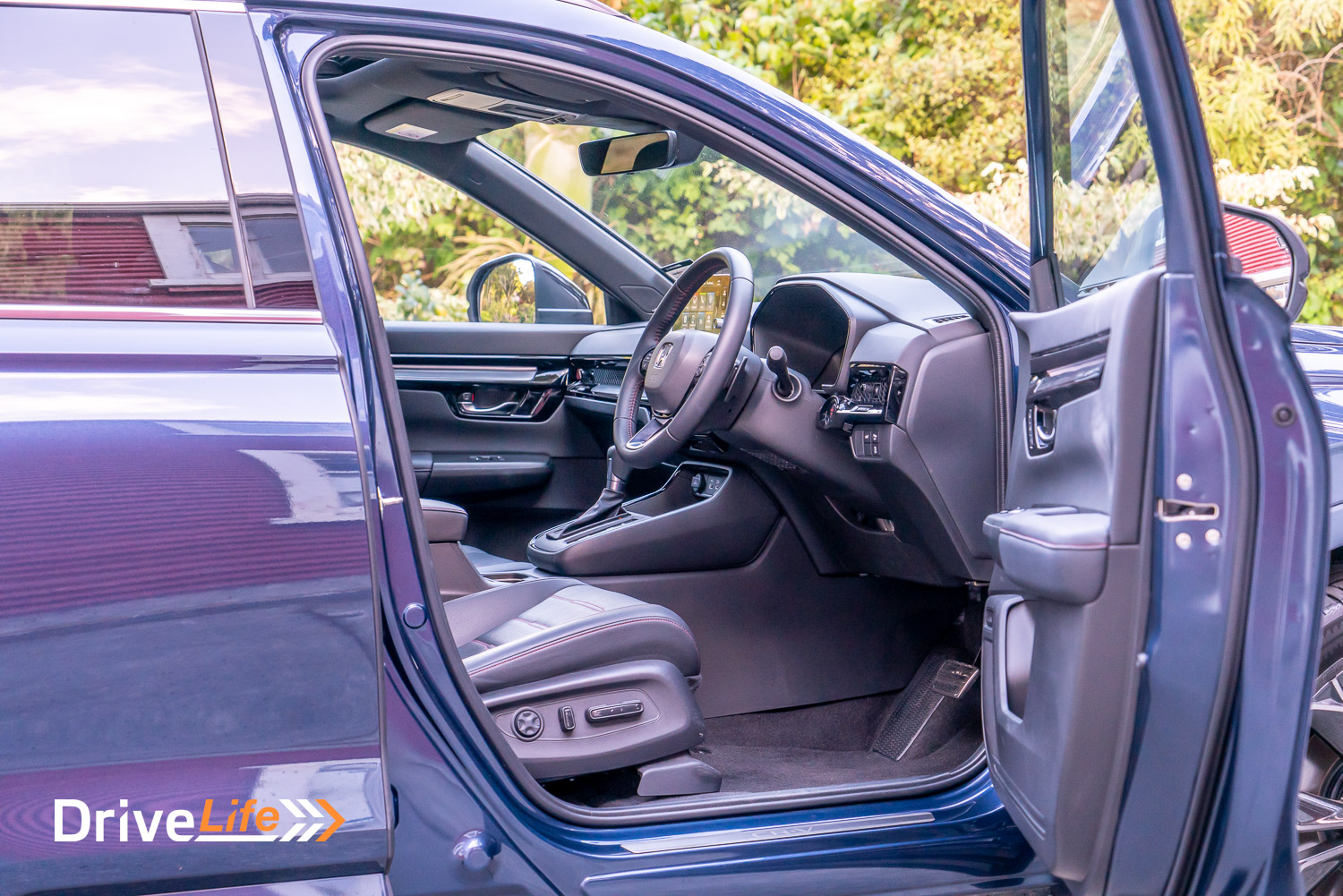
Those readers may remember captain’s chairs in the front, or the flat pass-through with a stowable picnic table. Perhaps it was the adjustability of the seats that stood out, or even the roominess of a tall cabin with hatchback dimensions (obviously more novel at the time). Whatever you recall, the CR-V was a clever SUV and it’s unsurprising that people loved it.
As the CR-V evolved through the generations, there have been fewer quirks (i.e. there’s no more picnic table), but it’s always remained true to its practical philosophy. The last generation, or the 5th generation CR-V, was basically a tardis on wheels.

The 6th generation CR-V interior is a completely fresh design. It follows a slightly different recipe from its predecessors, being more standardised with the rest of the Honda range. That said, it’s still massive on the inside but we’ll come back to that later.
From the CR-V’s front seats, the view looks an awful lot like the latest Civic. That’s because the dashboard, climate controls, steering wheel, infotainment and digital instrument cluster options, along with most of the switchgear are shared between the three cars (with minor modifications).
This approach has many advantages, specifically in that Honda can optimize one design and make it brilliant. To give credit where credit is due, Honda has done exactly that.

It’s a modern design which balances technology with legacy physical controls, meaning it has plenty of tech, but without the gimmicks. In other words, everything that should be a knob, is a knob, and everything that should be a button, is a button.
It’s functional, usable, and easy to live with – a blue jeans approach to interior design. Like your favourite blue pair, the cabin textures and build quality are excellent, with a fit-and-finish which punches alongside much more expensive European metal.
There is something to be said about a loss of identity with this approach, but seldom will it ever be irritating.


The 9-inch infotainment occupying the centre of the dash is Honda’s latest, containing all the usual features you’d expect for 2024. The tile-based UI is intuitive, and both the resolution and responsiveness are good.
It does have a few drawbacks, specifically, the screen feels plasticky to the touch and the reversing camera resolution leaves much to be desired. It’s also slightly surprising the CR-V doesn’t have a top-down, or 360-camera, particularly in the top-spec CR-V RS whereas most of the competition does.


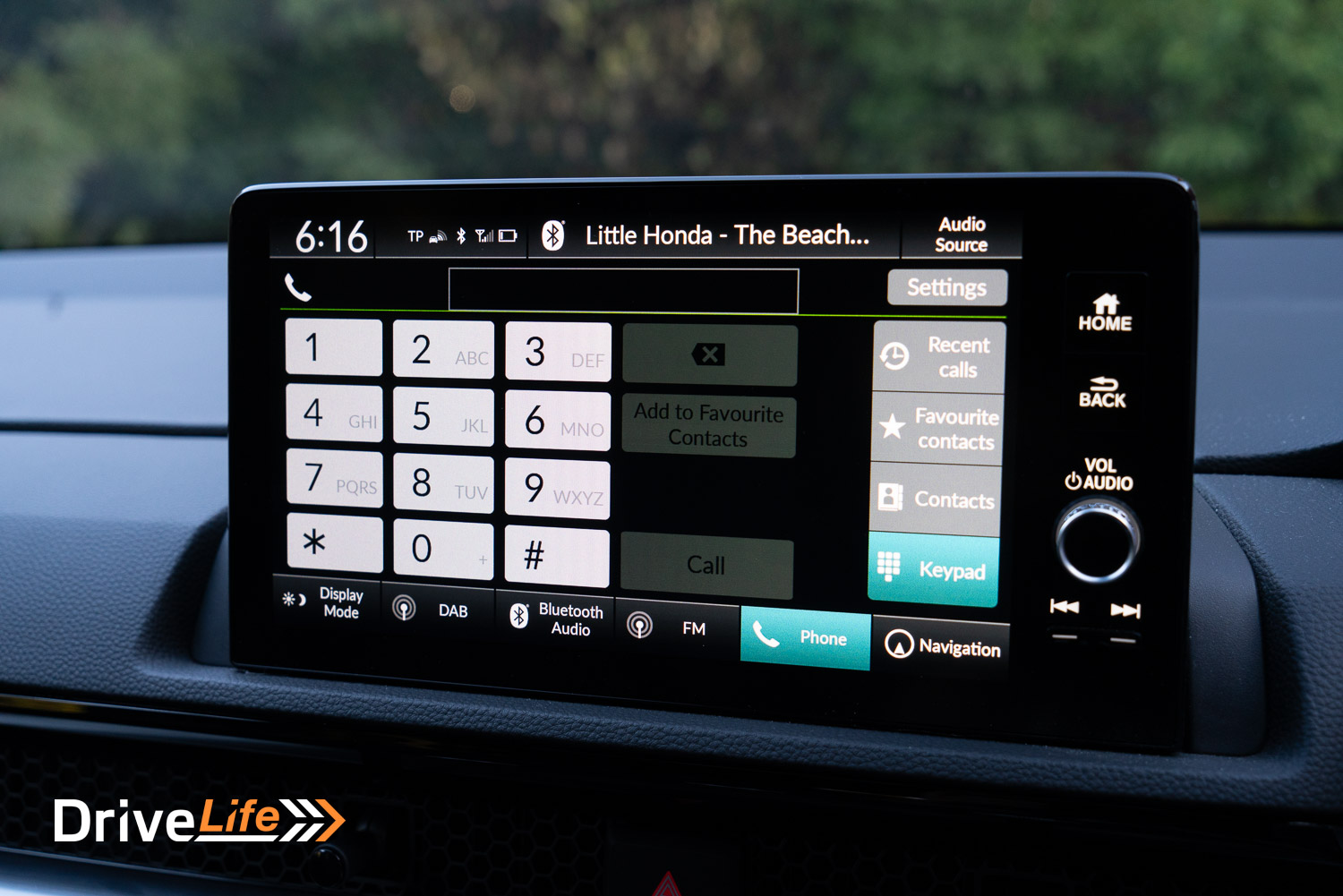


Although, the top-spec RS does bring with it plenty of other tech perks. In particular, the infotainment is paired with a 12-speaker Bose audio system, and there’s a 10.3’’ digital instrument cluster (instead of the half cluster in lower trims).
The Bose system in the CR-V is one of the better audio systems I’ve experienced in this segment, with good mid-range and bass depth.



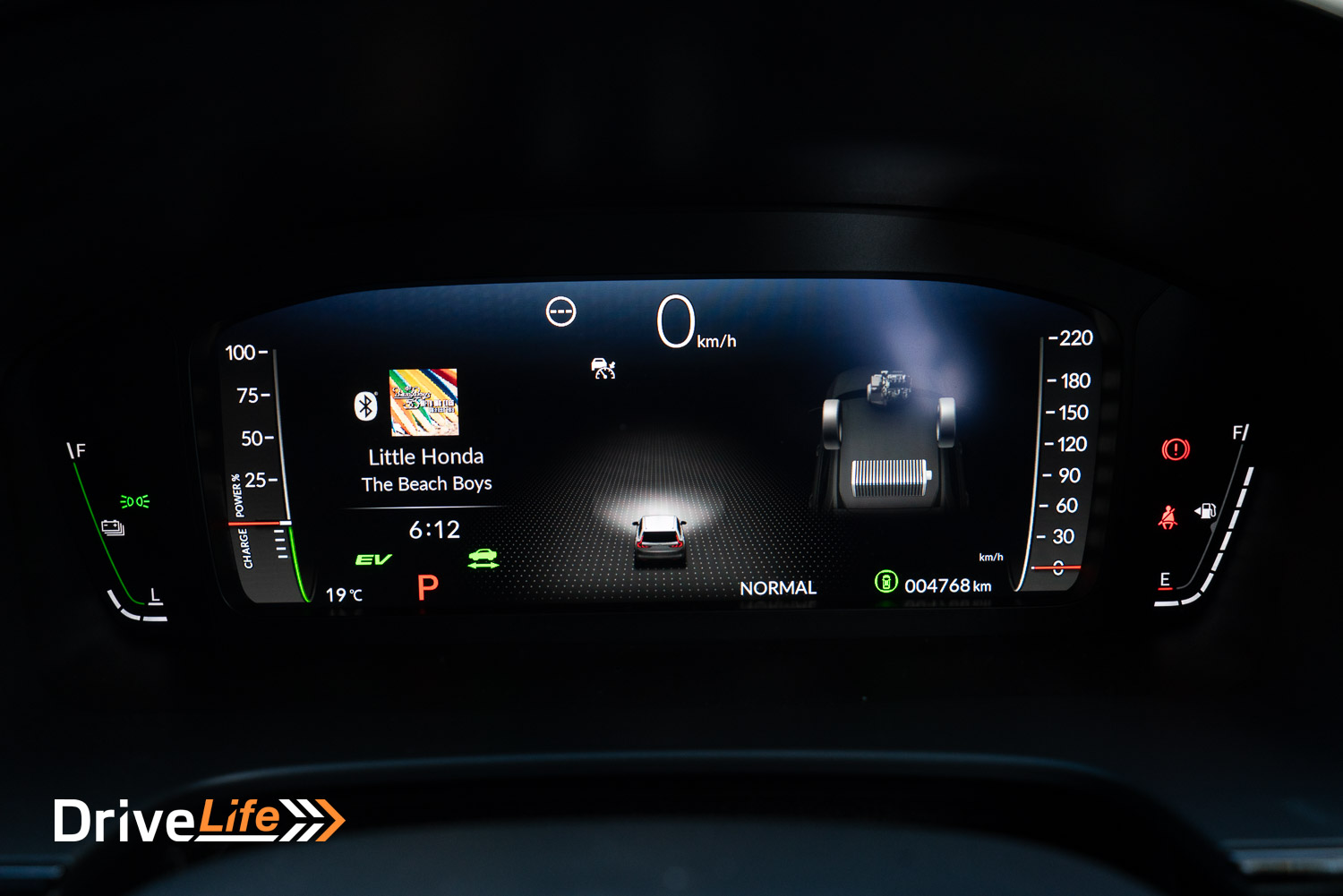
The digital instrument cluster is a nice upgrade, but not a must-have. It has minor levels of configurability, but not anything that’s substantially over and above the half cluster found in the lower trims. The cluster does have superior resolution, and you also gain an assistance view in the centre of the screen when the adaptive cruise and lane keep assistance are activated.
Although technology is an important aspect of which the CR-V does generally well, the CR-V’s ace has always been its interior space and the new CR-V is no exception.

The CR-V is probably an SUV equivalent of a Tupperware container. There is acres of space in the front and the back, and the cabin storage is also good. There’s room for two bottles in each door card, and could probably fit my head in the centre console (if I really wanted).
The driving position is good for an SUV – it’s tall enough for good outward visibility, without feeling like you’re in a high chair. The front seats also have plenty of configurability, meaning you’re not likely to have trouble finding a comfortable spot, even if you’re a fair bit taller than average. That said, I reckon the seat base could be a tad longer for more under-thigh support.

Those in the rear shouldn’t have any issues getting comfortable either, as the CR-V has always had class-leading rear legroom. The new CR-V extends that lead, adding even more legroom than before.
According to Honda, rear headroom is slightly diminished due to a higher seat base in the new car. Although you’re unlikely to notice unless you’re the size of Shaq. If it is a problem, the rear seats do recline.
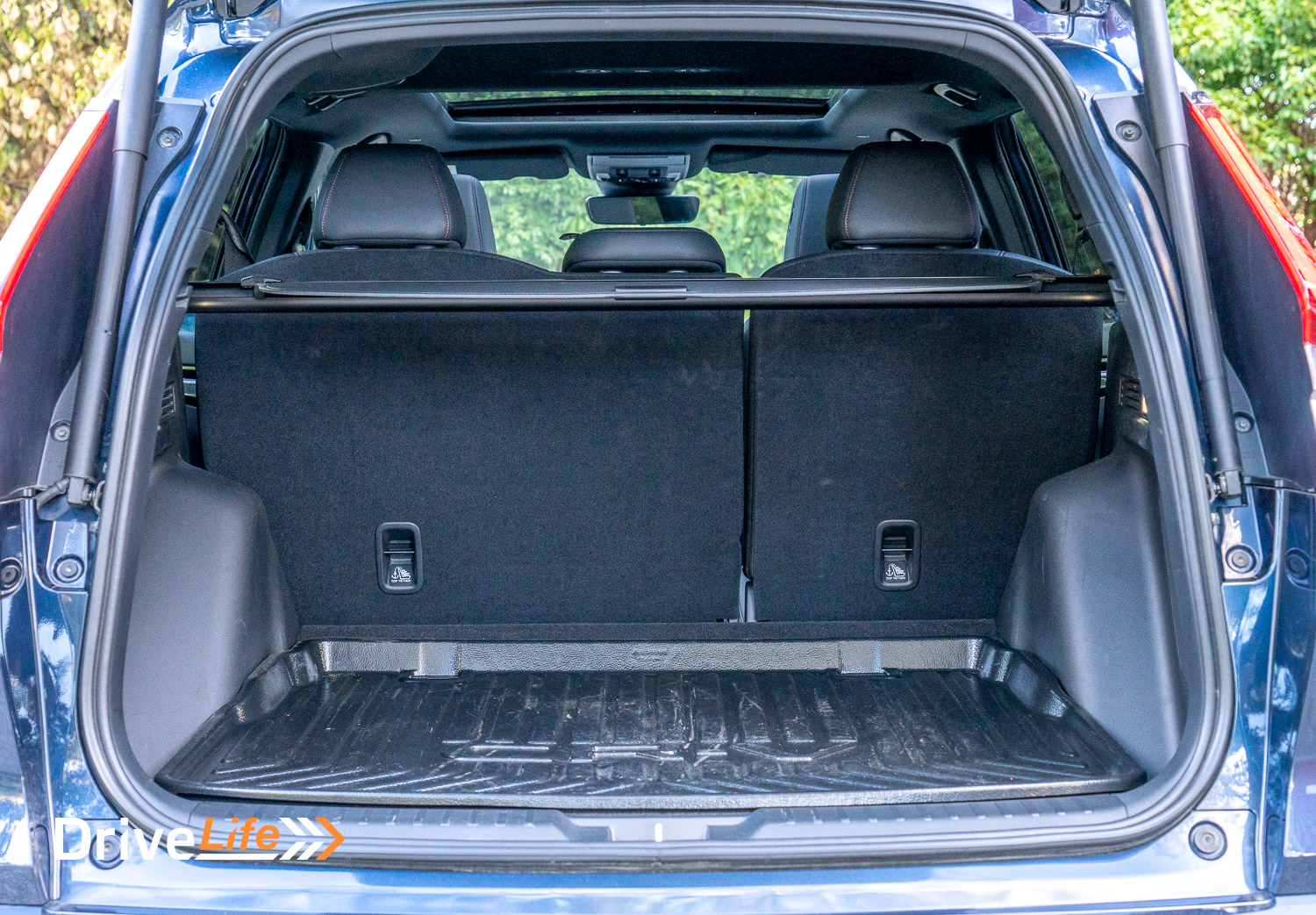
Although there are two drawbacks for the rear, one being more significant than the other. The lesser of the two is that the rear windows don’t go all the way down, which might be a minor irritation for the younger ones who like a good view out of the car. The bigger drawback for the new CR-V is the loss of Honda’s “magic” seats – those which can collapse into the footwell, or fold the seat base upwards. Apparently, Honda couldn’t feasibly incorporate these seats with the CR-V’s new platform design.
The rear seats do hinge forward slightly to collapse further into the floor, giving you fractionally more boot height when the seats are folded. It appears to make a difference for the cargo capacity, with the CR-V RS offering between 581L (seats up) and 1,636L (seats down) of space, even with its hybrid battery underneath the floor.



What’s The 2024 Honda CR-V RS Like To Drive?
It may come as a surprise to some of you to learn that Honda is the largest engine builder in the world. It’s also a brand which has a storied history in motorsport – arguably, as successful as some of the biggest names ever.
In recent years, Honda has been quite vocal about their disdain for the direction of modern automobiles, pointing the finger at other manufacturers for churning out the equivalent of a kitchen appliance on wheels.

Of course, a mid-size crossover like the CR-V is not exactly going to be the sort of vehicle that’ll ever be on a poster in an 8-year-old’s bedroom. Although Honda has been quite clear they want their cars to be engaging to drive, regardless of their role. A memorable experience for the driver, beyond a few fart noises coming out of the infotainment screen.
According to Honda, they’ve invested a fair bit of resource into making the newest CR-V better to drive than its peers, while still fulfilling its role as a family vehicle. On the surface, it’s a little difficult to see where Honda has made the new CR-V more engaging to drive. But when you start looking underneath, you’ll begin to see some of the clever engineering that’s gone into it.

In particular, there’s Honda’s new 2.0-litre e:HEV Hybrid powertrain, which is their newest approach for their hybrids. The e:HEV hybrid is a bit different, where it uses a combustion engine, electric motors, a generator, and a battery. The electric motors perform most of the driving, while the petrol engine works to power the generator, which charges the battery that powers the electric motor – you know the drill.
The petrol engine still does some driving at higher speeds (and occasionally at low speeds), where a clutch engages which switches the driving to the petrol engine. Due to this arrangement, Honda has basically been able to eliminate a conventional gearbox in favour of an “e-CVT”.
The “e-CVT” is more like a direct-drive unit as opposed to a conventional belt-driven CVT, because it refers to the combination of the electric motors and a series of clutches being in charge of the power flows. All of that may be a little tricky to follow, but its real-world outputs are quite convincing.
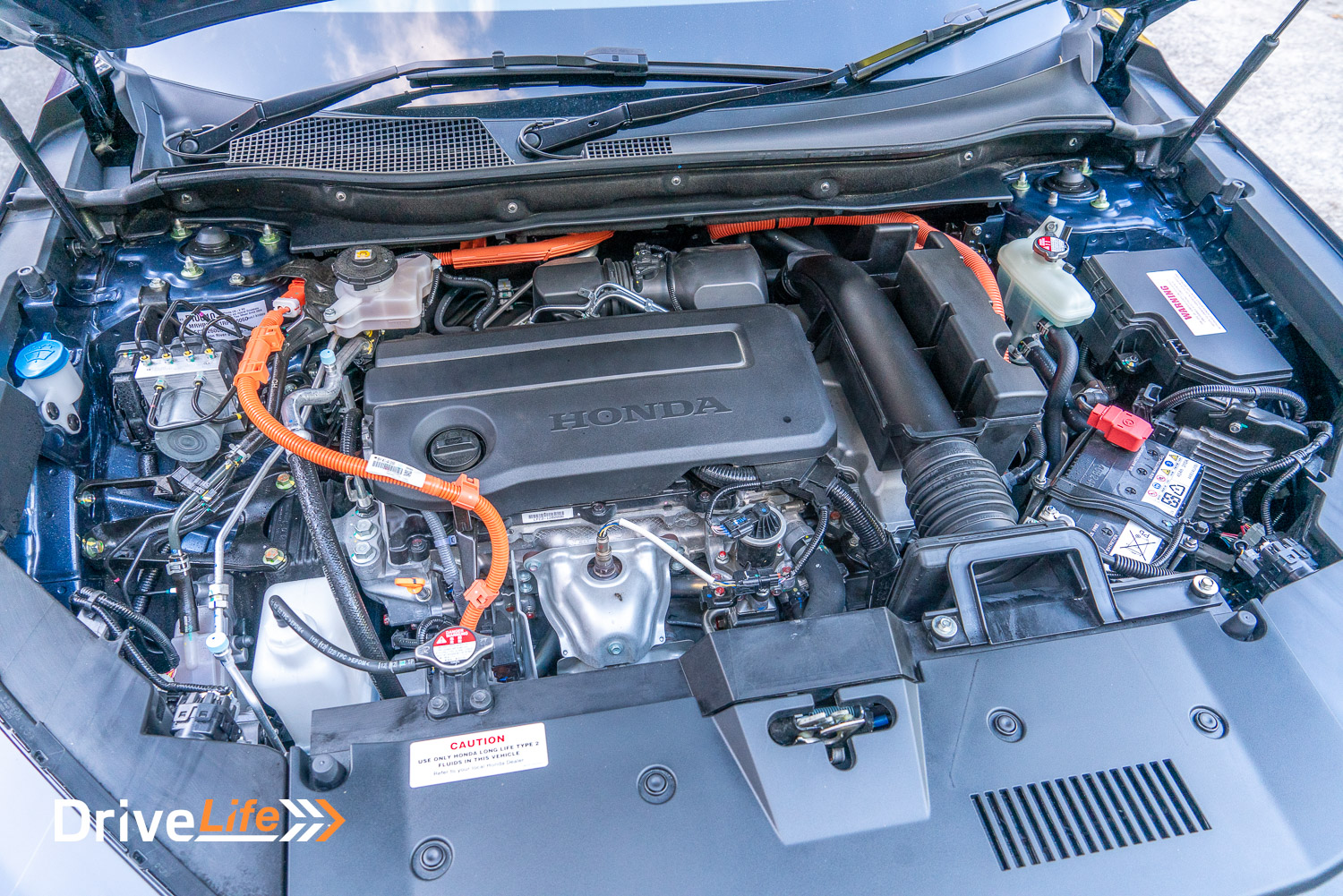
Performance-wise, the 2.0-litre e:HEV Hybrid powertrain outputs 135kW of power and 335Nm of torque. With that amount of torque on tap, the CR-V RS moves off the line with a convincing pace, performing the 0-100 kph dash in a smidgen over 7.5 seconds. The performance delivery is also exceptionally smooth, owing to the fact it’s mostly driven by the electric motor, and the e-CVT integrates the petrol engine near seamlessly, maintaining that overall powertrain smoothness on the open road.
Another by-product of the unique electric-petrol dance is the CR-V’s fuel efficiency. During our test, we managed to achieve a fuel economy figure of 5.9L per 100kms, which is lower than the CR-V RS’ claimed WLTP figure of 6.4L per 100kms.
Even during the launch of the CR-V, where we gave the CR-V RS a proper hoon through South Island backroads, we still returned a fuel consumption figure of 6.9L/100kms.

So yeah, the CR-V powertrain performance is really rather good. However, the CR-V’s performance delivery can feel rather synthetic. That’s because it’s delivering its performance with an EV-like linearity, but you can still hear an engine running. Honda’s even added noise, which rings out when you mash your foot down. I’ll admit, it’s an unnatural feeling, but you do adjust to it.
The CR-V also does lack a bit of power at the top-end, but that’s the norm in this mid-size crossover segment.
Altogether, the e:HEV Hybrid powertrain is a fairly trick unit, but of course, Honda hasn’t simply put all their eggs into the engine basket with the CR-V. They’ve also spent time enhancing the chassis.

In particular, the new CRV’s wheelbase is longer and the wheel track is wider. The CR-V’s body is 15% more rigid, as are the subframes, and there are more structural adhesives used. Together, amongst other chassis tweaks, Honda has made significant handling improvements and managed to reduce cabin NVH while doing so.
Those coming out of the last-gen CR-V will notice particular improvements in body control. The last-gen car could get a tad wobbly if you really leant on it in the corners, whereas the new CR-V has much tidier performance on fast and technical sections of road. Honda’s actually done it so well this time around, the CR-V is now one of the more competent handlers in its class – almost up there with the Mazda CX-5.
Despite all the extra stiffening, the CR-V RS is quieter than before and the ride quality is still good. The CR-V RS does get more sound deadening compared to lower-spec CR-V’s, but we’re told the new CR-V is generally quieter across the board.

If there’s any criticism, I’d say the ride quality is still a little underdamped on really patchy pieces of road. Although, for the school run, the motorway, and most state highways in New Zealand, it’s really quite good.
As for safety tech, the new Honda CR-V is equipped with everything you’d expect for 2024. Its adaptive cruise control is well calibrated, and the lane keep assistance functions reasonably well. I say ‘reasonably’ because it sometimes drags you a bit close to the edge of the lane.

On that subject, the lane-departure mitigation software was a bit too intrusive on narrow sections of road and it tends to over-correct. I elected to turn it off on many occasions, which is not something I often had to do for competitors. It’s a small irritation, I suppose.
The new CR-V also doesn’t have blind spot monitoring, but neither did the previous car. Blind spot monitoring tends to split opinion, with some finding it useful, and others not at all. Not a deal breaker, in other words.


2024 Honda CR-V RS – Specifications
| Vehicle Type | 4-door mid-size crossover |
| Starting Price | $67,000 |
| Price as Tested | $67,000 |
| Engine | 2.0-litre e:HEV 4-cylinder petrol hybrid |
| Power, Torque (kW/Nm) | 135/335 |
| Transmission | e-CVT |
| Spare wheel | Repair kit |
| Kerb Weight (Kg) | 1,771 |
| Length x Width x Height (mm) | 4704 x 1866 x 1681 |
| Cargo capacity (litres) | 581/1,636 |
| Fuel tank capacity (litres) | 57 (91 or higher) |
| Fuel Economy (L/100km) | Advertised Spec – Combined – 6.4 Real-World Test – Combined – 5.9 Low Usage: 0-6 / Medium Usage 6-12 / High Usage 12+ |
| Towing capacity (Kg, unbraked/braked) | 700/750 |
| Turning circle (metres) | 12.0 Small: 6-10m / Medium 10-12m / Large 12m+ |
| Warranty | 5-year/unlimited-km manufacturer’s warranty 5-year Roadside Assist 5-year Battery Warranty, 100,000km |
| Safety information | ANCAP Rating – 5 stars – Not assessed. Rightcar.govt.nz – 5 Stars – QCH471 |
Have you enjoyed this review? Be sure to join our monthly email newsletter list so you don’t miss a single review!








